Intel Core i7-11700K Review: Blasting Off with Rocket Lake
by Dr. Ian Cutress on March 5, 2021 4:30 PM EST- Posted in
- CPUs
- Intel
- 14nm
- Xe-LP
- Rocket Lake
- Cypress Cove
- i7-11700K
Power Consumption: Hot Hot HOT
I won’t rehash the full ongoing issue with how companies report power vs TDP in this review – we’ve covered it a number of times before. But in a quick sentence, Intel uses one published value for sustained performance, and an unpublished ‘recommended’ value for turbo performance, the latter of which is routinely ignored by motherboard manufacturers. Most high-end consumer motherboards ignore the sustained value, often 125 W, and allow the CPU to consume as much as it needs with the real limits being the full power consumption at full turbo, the thermals, or the power delivery limitations.
One of the dimensions of this we don’t often talk about is that the power consumption of a processor is always dependent on the actual instructions running through the core. A core can be ‘100%’ active while sitting around waiting for data from memory or doing simple addition, however a core has multiple ways to run instructions in parallel, with the most complex instructions consuming the most power. This was noticeable in the desktop consumer space when Intel introduced vector extensions, AVX, to its processor design. The concurrent introduction of AVX2, and AVX-512, means that running these instructions draws the most power.
AVX-512 comes with its own discussion, because even going into an ‘AVX-512’ mode causes additional issues. Intel’s introduction of AVX-512 on its server processors showcased that in order to remain stable, the core had to reduce the frequency and increase the voltage while also pausing the core to enter the special AVX-512 power mode. This made the advantage of AVX-512 suitable only for strong high-performance server code. But now Intel has enabled AVX-512 across its product line, from notebook to enterprise, allowing these chips to run AI code faster and enabling a new use cases. We’re also a couple of generations on from then, and AVX-512 doesn’t get quite the same hit as it did, but it still requires a lot of power.
For our power benchmarks, we’ve taken several tests that represent a real-world compute workload, a strong AVX2 workload, and a strong AVX-512 workload. Note that Intel lists the Core i7-11700K as a 125 W processor.
Motherboard 1: Microcode 0x2C
Our first test using Agisoft Photoscan 1.3 shows a peak power consumption around 180 W, although depending on the part of the test, we have sustained periods at 155 W and 130 W. Peak temperatures flutter with 70ºC, but it spends most of the time at around the 60ºC mark.
For the AVX2 workload, we enable POV-Ray. This is the workload on which we saw the previous generation 10-core processors exceed 260 W.
At idle, the CPU is consuming under 20 W while touching 30ºC. When the workload kicks in after 200 seconds or so, the power consumption rises very quickly to the 200-225 W band. This motherboard implements the ‘infinite turbo’ strategy, and so we get a sustained 200-225 W for over 10 minutes. Through this time, our CPU peaks at 81ºC, which is fairly reasonable for some of the best air cooling on the market. During this test, a sustained 4.6 GHz was on all cores.
Our AVX-512 workload is 3DPM. This is a custom in-house test, accelerated to AVX2 and AVX512 by an ex-Intel HPC guru several years ago (for disclosure, AMD has a copy of the code, but hasn’t suggested any changes).
This tests for 10-15 seconds and then idles for 10 seconds, and does rapidly go through any system that doesn’t run an infinite turbo. What we see here in this power only graph is the alarming peaks of 290-292 W. Looking at our data, the all-core turbo under AVX-512 is 4.6 GHz, sometimes dipping to 4.5 GHz. Ouch. But that’s not all.
Our temperature graph looks quite drastic. Within a second of running AVX-512 code, we are in the high 90ºC, or in some cases, 100ºC. Our temperatures peak at 104ºC, and here’s where we get into a discussion about thermal hotspots.
There are a number of ways to report CPU temperature. We can either take the instantaneous value of a singular spot of the silicon while it’s currently going through a high-current density event, like compute, or we can consider the CPU as a whole with all of its thermal sensors. While the overall CPU might accept operating temperatures of 105ºC, individual elements of the core might actually reach 125ºC instantaneously. So what is the correct value, and what is safe?
The cooler we’re using on this test is arguably the best air cooling on the market – a 1.8 kilogram full copper ThermalRight Ultra Extreme, paired with a 170 CFM high static pressure fan from Silverstone. This cooler has been used for Intel’s 10-core and 18-core high-end desktop variants over the years, even the ones with AVX-512, and not skipped a beat. Because we’re seeing 104ºC here, are we failing in some way?
Another issue we’re coming across with new processor technology is the ability to effectively cool a processor. I’m not talking about cooling the processor as a whole, but more for those hot spots of intense current density. We are going to get to a point where can’t remove the thermal energy fast enough, or with this design, we might be there already.
Smaller Packaging
I will point out an interesting fact down this line of thinking though, which might go un-noticed by the rest of the press – Intel has reduced the total vertical height of the new Rocket Lake processors.
The z-height, or total vertical height, of the previous Comet Lake generation was 4.48-4.54 mm. This number was taken from a range of 7 CPUs I had to hand. However, this Rocket Lake processor is over 0.1 mm thinner, at 4.36 mm. The smaller height of the package plus heatspreader could be a small indicator to the required thermal performance, especially if the airgap (filled with solder) between the die and the heatspreader is smaller. If it aids cooling and doesn’t disturb how coolers fit, then great, however at some point in the future we might have to consider different, better, or more efficient ways to remove these thermal hotspots.
Motherboard 2: Microcode 0x34
As an addendum to this review a week after our original numbers, we obtained a second motherboard that offered a newer microcode version from Intel.
On this motherboard, the AVX-512 response was different enough to warrant mentioning. Rather than enable a 4.6 GHz all-core turbo for AVX-512, it initially ramped up that high, peaking at 276 W, before reducing down to 4.4 GHz all-core, down to 225 W. This is quite a substantial change in behaviour:
This means that at 4.4 GHz, we are running 200 MHz slower (which gives a 3% performance decrease), but we are saving 60-70 W. This is indicative of how far away from the peak efficiency point that these processors are.
There was hope that this will adjust the temperature curve a little. Unfortunately we still see peaks at 103ºC when AVX-512 is first initiated, however during the 4.4 GHz time scale we are more akin to 90ºC, which is far more palatable.
On AVX2 workloads with the new 0x34 microcode, the results were very similar to the 0x2C microcode. The workload ran at 4.6 GHz all-core, reached a peak power of 214 W, and the processor temperature was sustained around 82ºC.
Peak Power Comparison
For completeness, here is our peak power consumption graph. These are the peak power consumption numbers taken from a series of benchmarks on which we run our power monitoring tools.
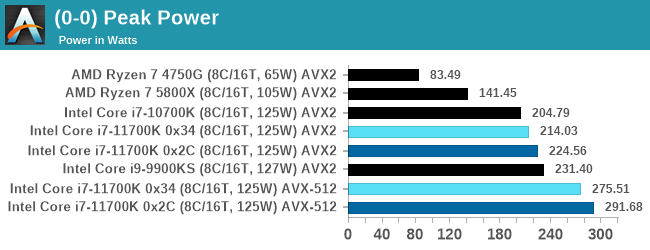



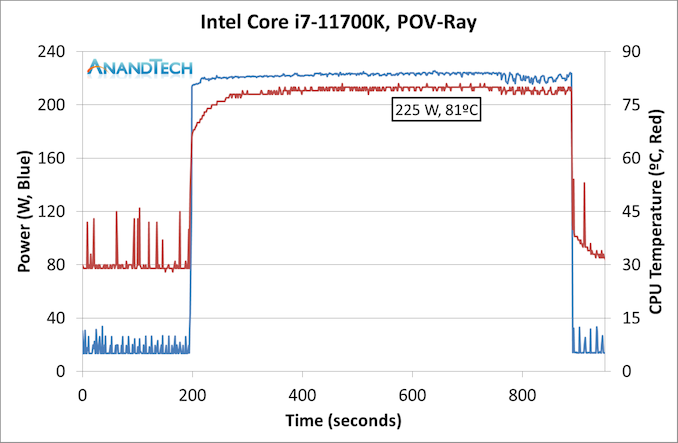
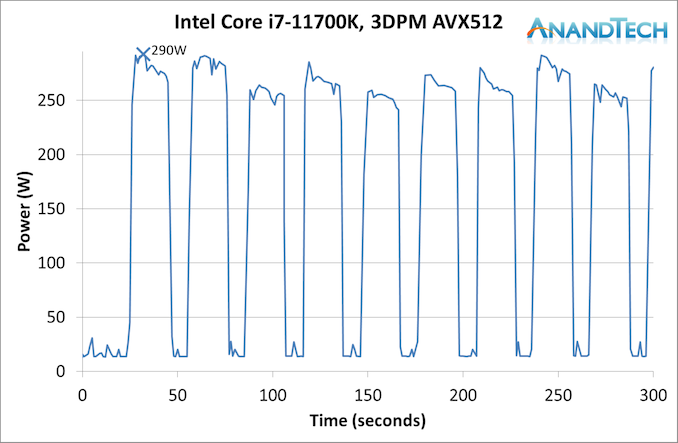
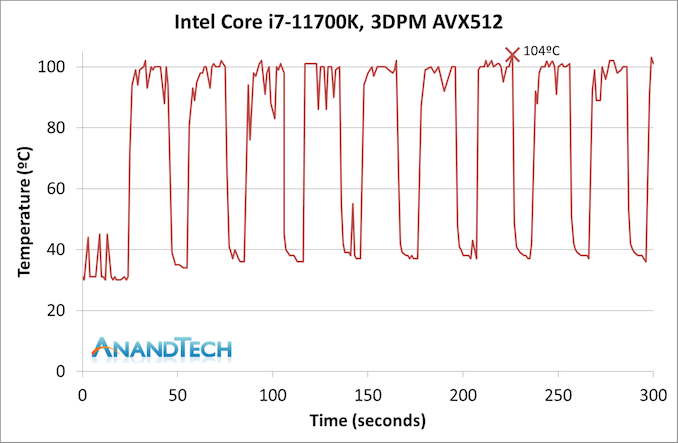


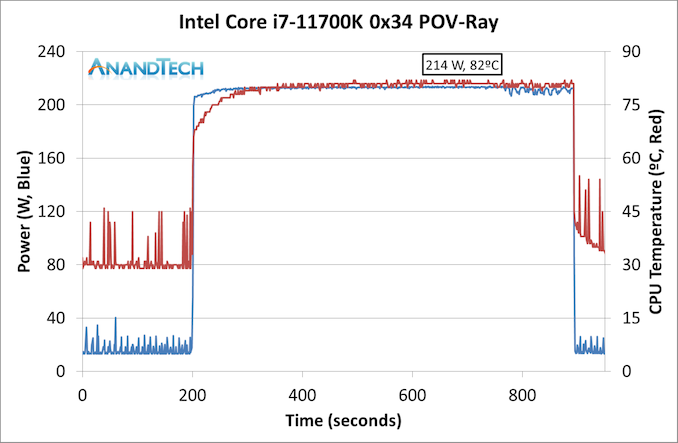








541 Comments
View All Comments
Gigaplex - Sunday, March 7, 2021 - link
They only disable the parts that aren't required.Qasar - Sunday, March 7, 2021 - link
abufrejoval the times i have seen a intel cpu with, and with out an igp, for sale there was no price differenceSpunjji - Monday, March 8, 2021 - link
"die area Intel is giving away for free (they basically charge $5 for an iGPU)"Trying to fathom the cost of Intel's iGPU by seeing what they charge for a SKU with it disabled (but still physically there in silicon) is a fool's errand.
Intel don't give anything away for free - their margins didn't go down after they put their iGPU on-die.
IUU - Saturday, March 6, 2021 - link
Whatever the advantages of the new microarchitecture, Intel managed to negate them all, by trying to sell overclocked products. Once upon a time when you overclocked a chip Intel would void your warranty. Sometimes it would directly ban overclocking or distinguish its products between these that can be overclocked and these that can't be.I would buy a true 125W TDP chip, with a new microarchitecture, even knowing it is slower, with a reasonable price of course. I would not buy overclocked chips at any price. If Intel wants to command prices comparable with AMD, they need to offer chips with comparable performance per watt power.
It would be less embarrassing for them to sell a 70% slower product with the right power than an equal regarding speed chip with twice the power draw. In my eyes of course. There are people who only care about speed , no matter the power or the money.
You can have a fast porsche, or a fast ferrari, or a fast koenigsegg.
And you can have a fast dragster.
Not the same thing.
Gigaplex - Sunday, March 7, 2021 - link
Define overclocked. It really just means clocking higher than the manufacturers specifications. If Intel is defining the clock speed it's not overclocking.Techie2 - Saturday, March 6, 2021 - link
While AMD CPUs may be difficult to find at suggested retail prices, it's FAR better to buy the AMD CPU than a POS back ported overheating Intel CPU if you can find one.For the record I have documented that several sources including Newegg have been selling the Ryzen 5 5600x @ $299. as soon as they receive stock which appears to be weekly or more frequently. Newegg advertises the $384 CPU price and (5) offers. When you click on the item you see the $299. Newegg shipped item when they are actually in stock for a short period of time. THAT is when people should buy and not support scalpers with inflated prices. It's worth checking Newegg frequently as they are not advertising the $299. price much with so many scalpers on their network.
In addition for anyone near a Micro Center they are only selling in-store but they have had a continuous supply of AMD 5000 CPUs for some time and at the correct price. This should be the first choice for anyone located near a Micro Center store because there are no games or price gouging involved.
zodiacfml - Saturday, March 6, 2021 - link
shocking. Intel allowed some retailers to sell the CPU as the shortage in AMD is severe.jayjr1105 - Saturday, March 6, 2021 - link
5600X 5800X are becoming readily available recentlyHifihedgehog - Saturday, March 6, 2021 - link
This.Antares8001 - Saturday, March 6, 2021 - link
So what it the point of Rocket Lake?The fact that it is only available with a maximum of 8 cores makes it pretty undesirable for most workstation tasks, compared to competition from AMD and even themselves. Also the fact that they seemingly sacrificed their architectural advantage for games to a point where it gets outperformed comet lake makes it seem like a chip that is completely dead on arrival with no viable market whatsoever.
As it is it does everything worse than both zen 3 and comet lake while running a lot hotter and consuming more power.
I mean great that intel managed to backport it to 14nm, but what the hell was the point.